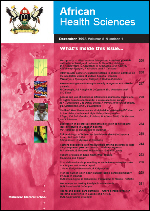
|
African Health Sciences
Makerere University Medical School
ISSN: 1680-6905
EISSN: 1680-6905
Vol. 20, No. 1, 2020, pp. 4-13
|
 Bioline Code: hs20004
Bioline Code: hs20004
Full paper language: English
Document type: Research Article
Document available free of charge
|
|
|
African Health Sciences, Vol. 20, No. 1, 2020, pp. 4-13
| en |
Bacteriospermia, extended spectrum beta lactamase producing Gram-negative bacteria and other factors associated with male infertility in Mwanza, Tanzania: a need of diagnostic bacteriology for management of male infertility
Silago, Vitus; Mukama, Yusuph; Haule, Anna L; Chacha, Frank; Igenge, John; Mushi, Martha F & Mshana, Stephen E
Abstract
Background: Infections caused by Extended spectrum beta lactamase (ESBL) producing bacterial are global challenge. There is limited information on the magnitude of bacteriospermia, ESBL producing Gram-negative bacteria (GNB) causing bacteriospermia and factors associated with male infertility. This study determined magnitude of bacteriospermia, ESBL-GNB and other factors association with infertility among presumptive infertile men in Mwanza, Tanzania.
Methods: A cross-sectional hospital-based study was conducted between May 2017 and July 2018 among 137 presumptive infertile men. Semen specimens were self-collected by masturbation into clean, sterile and none-spermicidal containers and processed following laboratory standard operating procedures (SOPs). Data analysis was done using STATA 13.0.
Results: Gram-negative bacteria were predominantly isolated (86.4%), of which 31.6% were ESBL producers. In a total 44 bacteria were isolated from semen culture. The blaCTX-M gene was detected in 75% of phenotypically confirmed ESBL producers. Infertility was independently found to be associated with abnormal spermatozoa morphology (OR (95%CI): 14.48(3.17-66.05)) and abnormal spermatozoa motility (OR (95%CI): 0.05(0.01-0.24)). However, neither bacteriospermia (OR (95%CI): 0.86(0.29-2.59)) nor ESBL bacteriospermia (OR (95%CI): 0.13(0.01-1.22)) was found to be associated with infertility.
Conclusion: One third of bacteriospermia is due to ESBL-producers with history of antibiotic use being protective factor for infertility. Abnormal spermatozoa morphology and poor spermatozoa forward motility independently predicted infertility.
Keywords
bacteriospermia; blaCTX-M; male infertility; extended spectrum beta lactamase; Mwanza; Tanzania.
|
| |
© Copyright 2020 - Silago V et al.
|
|
